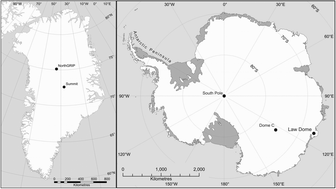Chemical signals of past climate and environment from polar ice cores and firn air†
Abstract
Chemical and isotopic records obtained from polar ice cores have provided some of the most iconic datasets in Earth system science. Here, I discuss how the different records are formed in the ice sheets, emphasising in particular the contrast between chemistry held in the snow/ice phase, and that which is trapped in air bubbles. Air diffusing slowly through the upper firn layers of the ice sheet can also be sampled in large volumes to give more recent historical information on atmospheric composition. The chemical and geophysical issues that have to be solved to interpret ice core data in terms of atmospheric composition and emission changes are also highlighted. Ice cores and firn air have provided particularly strong evidence about recent changes (last few decades to centuries), including otherwise inaccessible data on increases in compounds that are active as greenhouse gases or as agents of stratospheric depletion. On longer timescales (up to 800 000 years in Antarctica), ice cores reveal major changes in biogeochemical cycling, which acted as feedbacks on the very major changes in climate between glacial and interglacial periods.

- This article is part of the themed collection: Atmospheric chemistry

 Please wait while we load your content...
Please wait while we load your content...